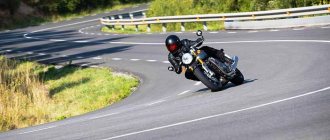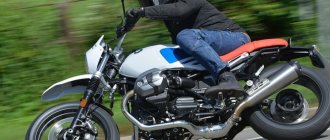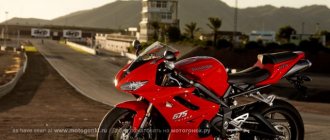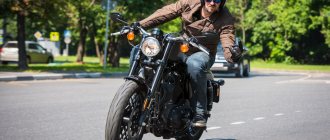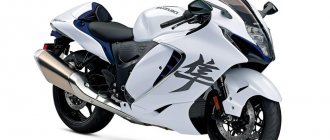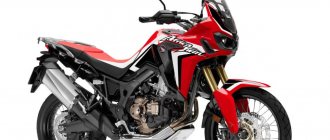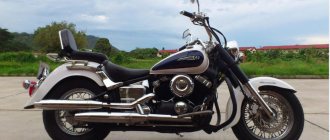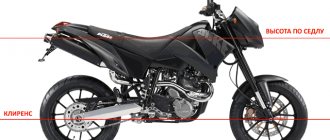Test drive Triumph Bonneville SE
Editor's note: This happens extremely rarely. At least, in our memory this has only happened a couple of times - when the material written by a foreign journalist after a test drive of a motorcycle would have been reminiscent of Michelangelo’s sculpture “Discoball” - when nothing could be added or taken away. When the content of the text so accurately matches the spirit and essence of the motorcycle that reading the numbers, looking at graphs and comparing seconds of acceleration dynamics is like trying to describe passion itself with mathematical formulas. Such an approach to such an unusual motorcycle is akin to cacophony in the music world. Harmony – isn’t this what we should all strive for in this life? That is why we decided to bring to your attention an article by our Polish colleague from the Sczigacz magazine.
"Bonnie" - the story of a legend
The name Triumph Bonneville takes us back to the distant 60s, when this motorcycle captivated the hearts of thousands of motorcyclists. If until the 50s the name Triumph was associated exclusively with motorcycles of the Thunderbird model (on which Marlon Brando starred in the film The Wild One), then the Bonneville came to the fore later. Moreover, the change in the flagship of the model range was not at all connected with the advertising campaign, but with the outstanding achievements of this bike. After all, from 1956 to 1966, all world achievements in setting speed records were achieved by motorcycles based on the 650 cc engine from Triumph Bonneville. And the name of the motorcycle itself has sporting roots.
In 1956, Texas racer Johnny Allen set a world speed record at Bonneville Salt Lake in Utah on his aerodynamic Devil's Arrow motorcycle, accelerating to 311 km/h. At the same time, his motorcycle was equipped with a 650 cc 2-cylinder in-line Triumph engine running on pure methanol. This was the first sign of Triumph's success in the American market, and it was in honor of this achievement that the British named their new T120 motorcycle, released in 1959, the name Bonneville.
Later, of course, there were other records associated with the name “Bonnie”. After Johnny Allen, Wilhem Herz shows a speed of 338 km/h in his converted Triumph Bonneville! But Allen breaks this record some time later, reaching a speed of 345 km/h! This record could not be broken for several years - right up until 1962, when William Johnson managed to accelerate to a mind-blowing at that time 361.41 km/h... again, in a converted Bonneville! And finally, the final touch from those glorious years is 1966. Then Robert Leppan reaches 395.28 km/h. This record was broken only a year later by a turbocharged two-stroke 700 cc Yamaha. But this no longer mattered, because over the course of several years the Triumph Bonneville became an absolute dream motorcycle among athletes and ordinary motorcyclists.
Triumph Bonneville T120
Released in 1959, the Triumph Bonneville T120 literally blew up the market and became a legend during its lifetime. It was equipped with a 650 cc two-cylinder parallel twin engine, and even in stock it easily reached a speed of 185 km/h - an indicator unprecedented for production motorcycles of those years. In addition, in 1963, the motorcycle was made famous by Hollywood actor Steve McQueen, who starred on it in the film “The Great Escape.” Over the following years, designers and engineers constantly modernized the Bonnie, and more and more new versions were released - T120, T120R, T120C, T120TT, T120R, T120V.
Triumph Bonneville T140
In 1972, the updated Triumph Bonneville T140 was released. At first it was equipped with a 724 cc engine of the same configuration, and later its capacity increased to 744 cm3. Thanks to its high power performance, this model successfully competed in many markets with Japanese and Italian motorcycles. And in 1979, the Triumph Bonneville T140 won the Motorcycle of the Year competition held by the leading British magazine Motorcycle News. The last 140 Bonnie was released in 1988, after which there followed a long break in the production of these legendary motorcycles.
New era
The modern history of “Bonnie” began in 2001, when the Triumph Bonneville 790 model was released. A year later, a limited version of the T100 was released. Since 2005, a new 865 cc engine began to be installed on the T100 version, and since 2007 on the regular Bonneville. Up until this time, all Bonneville models were equipped with carburetors, but in 2008 they were replaced with injectors.
Now the classic Triumph model line is represented by three models: Bonneville, Bonneville SE and Bonneville T100 - each is a reflection of glorious events in the history of the company. And if the Bonneville T100 is truly a classic “Bonnie,” then the Bonneville SE is a standard Bonneville plus a number of pleasant additions: the dashboard is decorated with a tachometer and speedometer, the sides of the gas tank are chromed and have classic Triumph brand emblems on them. Optionally, you can order a two-tone color, which gives the model a special individual and memorable look.
Text: Lukasz Tomanek
Photo: provided by the author
Hello from the past
When a person has prolonged depression or is simply in a sad mood, in our 21st century many products of modern civilization can help him. They will fill the world with colors, make the sky blue again, and the trees green, saturate the soul with a soothing balm... We have TV with “Our Russia”, the TV series “Univer”, whiskey + Coca-Cola, and a lot of other ways to entertain yourself. Perhaps some of these things work very well, but still, there is another, more original way using a unique gadget. And that downer is Triumph Bonneville.
Everyone will love "Bonny"
The Bonneville is an iconic motorcycle. If you are no longer young, then looking at him, you will go back to a good thirty years ago, when girls wore polka dot dresses, and the biggest trouble was a bad grade at school or university. If you are a little younger or not at all interested in motorcycles, you will most likely still like Bonnie. We asked the opinions of people from different social classes, with different interests and different ages. Nobody said anything bad about this Triumph model, although everyone liked the bike to varying degrees. And how can you not like him? I am sure that the Bonneville is the sexiest motorcycle creation of mankind in history! And, looking at the smooth curves of the lines, the special “metallic” grace, you begin to understand why this is so. Personally, I can’t look at the engine for a long time, because it causes me certain physiological effects that are reserved for Anfisa Chekhova in case I suddenly find myself on the same big sofa with her. Ohhhhh!…
The only thing that can be changed in it is the wheels, but this is a matter of taste.
On a gray sad Monday
Agree. “Bonnie” awakens unbridled desire in a person with her appearance and clothes of that era. Military boots, washed-out jeans, black leather, a chain on his pants, a sharp and brutal smell of cologne... This motorcycle feels the spirit of rebellion of those years with a slight sprinkling of glamor and hooligan elegance. It's all about him, but at the same time the Bonnie remains a very friendly civilian motorcycle.
The layout of the controls is almost exemplary, even despite the fact that the rider's legs are bent at the knees quite strongly, and the gear shift paw is located too high and has a huge stroke.
You won’t be able to relax on a beautiful “sofa” either - after a few kilometers you will miss your soft leather chair by the fireplace and look for the ideal rear suspension settings. Unfortunately, other than adjusting the spring preload, there is nothing to adjust there.
But, even taking into account these unflattering ergonomic facts, the Bonnie is very pleasant to drive. The steering wheel has an ideal shape and fits like a glove in your hands, you can squeeze the clutch with two fingers and still feel its work perfectly. Thus, we come to a consensus. The Bonneville is not just a motorcycle for every day, it is a motorcycle for those days when people give each other cards.
Product of the Divine Forge
We have already said above that the engine is strikingly beautiful. But how does it work? This two-cylinder parallel twin, licked to perfection by factory mechanics, has a high level of performance and develops decent traction. The Bonnie has cable-operated throttle control rather than the newfangled electronic throttle control - it's a special touch of nostalgia and a reminder of the times when the most complex electrical system on any motorcycle was the magneto.
Thus, sitting on the Bonneville, we get 68 hp. power and 69 Nm of thrust, which are in the complete control of the driver. This is more than enough for a measured ride, and quite enough for a dynamic one. The engine is surprisingly elastic and has a good running culture, although I, in my opinion, am repeating myself, but the impression of its operation is so strong that I cannot help but talk about it. Of course, it has a slightly noticeable British phlegmatic quality, which manifests itself as a soft response to turning the throttle in any gear.
Dear reader, I have an urgent request to ask of you. If you buy a Bonneville, be sure to replace the exhaust system. To my great regret, the factory system does not allow the motorcycle to breathe fully and kills the enchanting sound of the parallel twin. It's like watching the premiere of a brilliant film through a keyhole...
When accelerating, the speed rises with a pleasant, growing purr, but upon reaching the upper limit, the engine begins to openly lose its rhythm, as if snorting. Interestingly, many journalists viewed this feature as extremely positive, but I did not like it.
The Triumph brand has never been the subject of criticism regarding the handling of its models, and the Bonny is no exception. It can easily change direction, but also maintains its chosen trajectory well. The only situation that makes Bonnie nervous is crossing longitudinal cracks in the asphalt. Because of the narrow tires, the motorcycle takes on a life of its own for a brief moment. The standard tires themselves cling well to both dry and wet asphalt - thanks to Metzeler for that.
Of course, there is no ABS here - after all, installing this system on it would be akin to blasphemy. Try dressing a forest nymph in a mini, gold and diamonds and stiletto heels, and who will we get? You guessed correctly... The front brake has good information content and high efficiency. The rear one is very tenacious and can even block the wheel. This could be a serious problem and even lead to an uncontrolled skid... if you were 14 years old.
Over the counter
The only real and significant competitor for the Bonneville available in Ukraine is the Kawasaki W800, but still, with some stretch. There is also a revived Norton, but it is still completely exotic for us. Of course, I'm not talking about their technical characteristics. No one will say: “Hmm. Well, I don't know... I can't choose between Bonneville and Hayabusa! The subjects of competition are style, charisma and the emotions that the bike gives to its owner.
Triumph has few shortcomings, and those that exist are easily overcome. This is a bright and original motorcycle that will really distract you from depression. It can dramatically change your mood and paint a smile where just recently there was sad territory. At the same time, you don’t need to prove anything to anyone, because you are going to “Bonnie”, and with this one fact you have already proven everything to everyone. You can ride this bike fast and aggressively, but it's like forcing famed Hollywood composer and Oscar winner Hans Zimmer to write dubstep.
This motorcycle makes you feel more calm, as if philosophically, about the world around you. Idiots in cars, road works on the most congested streets, or 40 km/h speed limit signs on straight and smooth roads will no longer annoy you and drive you crazy.
For me, this motorcycle will remain the epitome of sexy in metal, rivaled only by the two-wheeled version of Lady Olivia Wilde. Taking this into account, would you want to own such a bike?
Don't deny yourself because you won't be disappointed. I promise.
Text: Vladislav Sofonov
Photo: Triumph
Triumph Bonneville T120
Albion first encountered Bonneville in 1959. Then the motorcycle bore the same index as our current hero - T120.
The numbers indicated nothing more than the maximum speed in miles per hour. For ’59, it was, if not the fastest, then one of the fastest motorcycles that money could buy! Two cylinders in line, 649 cc. cm, 52 hp, four-speed gearbox and 183 kilograms of dry weight.
Of course, even then the “Bonnie” had a characteristic gas tank and such a recognizable (and quite traditional for those years) seat. And even though my fellow motorcycle journalists were only able to accelerate it to 108 mph when testing the new motorcycle, this did not stop the Bonneville T120 from becoming the founder of a glorious dynasty. For almost sixty years, the model, albeit with interruptions, has been on the assembly line! We’ll leave more detailed historical research to a separate section; it’s better to talk about matters that are not so distant.
The direct “ancestor” of our “Bonnie” is the T100 model, which was produced until last year, 2015. We remember what it was like: of course, a classic look, a flat seat, a bean-shaped gas tank, an in-line two-cylinder air-cooled engine, 865 cc. cm and 68 hp, five-speed gearbox and... no electronics! Maybe the engine control unit. Actually, the model lasted on the assembly line without major changes for more than 10 years - since 2004. It seems like a classic, stable demand, proven design... But in our age, standing still is tantamount to death. And the time has come to update.
It’s worth starting with the fact that the guys from Hinckley had no intention of updating such an ancient model. The new Bonneville was painted from scratch. Don’t let its appearance confuse you: a classic, as we have already said, should remain so, so there were no experiments with design. Prim, conservative, painfully familiar classic! To find the differences, you will have to put the two motorcycles side by side and look closely. But there’s no other way - Ace Café regulars will throw old rags at you. But the filling has changed radically, and it’s inside that all the fun lies!
ENGINE
The cubic capacity of “825” in the modern table of ranks of motorcycles does not fall under any class. And not 800, and not “liter”. Therefore, the new “Bonnie” received a completely new engine with a displacement of 1198 cc. see. Moreover, it is obvious that dragging the old “air vent” through the environmental “eye of the needle” in 2016 seemed unrealistic, and why?
The new engine received a liquid cooling system. But in order not to spoil the classic appearance of the in-line “two”, the radiator was modestly hidden between the frame pipes, and all the pipes and channels of the cooling circuits were removed inside the engine. The outside is a clean silhouette. In principle, a familiar story. The Japanese came up with this method many years ago, trying to give an “airy” appearance to their “water” cruisers - just remember the Honda Steed 400. In general, an old, proven recipe!
The engine received the index HT - high torque, which means “increased torque”. And for good reason: the engine develops 80 hp. and 105 Nm of torque! The same engine also has a “high-speed” High Power (HP) modification – it is installed on the “evil” Thruxton and develops 96 hp.
The motor is “trained” in the best traditions: it is a gentleman with an ideal upbringing and the manners of an aristocrat! From the first seconds of work, the sound captivates. Not a single unnecessary noise or knock, no interruptions or wheezing, and both the engine and the exhaust sound equally clean. Absolutely musical engine! Moreover, as the speed increases, no “false notes” appear in his voice. Absolutely pure, academic, I would say, voice!
The same can be said about his character. The engine pulls confidently from the very bottom, and the traction remains smooth throughout the entire rev range, except that it turns sour a little towards the very top. But there is no need to rev such an engine on such a motorcycle, because the most “delicious” here is concentrated in the lower and middle ranges of the tachometer. Due to the juicy torque, the engine seems more powerful than it actually is. The engine confidently propels the motorcycle beyond the first “hundred” - quickly, but without lifting your hands or any nervous outbursts. Acceleration is assertive, smooth and powerful. In short, the new 1,200 cc engine will be appreciated not only by fans of the model who have long wanted something more powerful, but also by neophytes who are not burdened with an overly violent character.
EXTERIOR
Perhaps today it is already difficult to find a motorcycle that is not equipped with electronic assistants, unless, of course, you take into account the very starting models of small cubic capacity. Bonneville, of course, is not one of these. Even a retro image does not allow a modern motorcycle to be “retro” in its essence. Of course, in many ways this does not concern our American “colleagues,” but this is what the market demands. The British are not the Yankees. The motorcycle’s electronics are based on a single CAN bus, and the system architecture is borrowed from its “bigger” brothers. When I got behind the wheel of the Bonnie, I immediately figured out the controls and logic of the menu and other systems that were already familiar from the Triumph Explorer.
The throttle handle is connected to the throttle valves exclusively by wires, there are no cables. By the way, throttle bodies disguised as old-school carburetors are a traditional Bonneville solution. And, in my opinion, it’s extremely successful: the “warm tube” carbs are pleasing to the eye! I immediately remember the old wars with quality-quantity propellers, and how could it be otherwise on such a machine (well, at least externally)! The electronic connection between the handle and the motor made it possible to program different engine operating modes. In this case, there are two of them: standard and rain, when the engine’s response to the pilot’s commands is slightly damped, and the traction control tightens its “collar” a little tighter, not allowing the rear wheel to slip even a few degrees.
Yes, of course, here, for the first time on the Bonneville, switchable traction control also appeared. On the previous generation of the “old man” - T100 - it should be noted that there was not only traction, but even ABS! However, the golden age of “analog” technology has already ended. Starting this year, in Europe it is generally prohibited to sell motorcycles that are not equipped with ABS, so the release of motorcycles without it will not be a simplification, but a complication of the design. In short, now the Bonneville meets all safety requirements and the title of a modern motorcycle.
By the way, it’s especially nice that on such a seemingly recreational motorcycle, the base already has heated handlebars installed. For many, this feature is still an option. What can I say, there is even a USB socket under the seat! Of course, you won’t be able to listen to music, but you can charge your mobile phone or a helmet headset that died at the wrong time. Here's a British classic for you - grandpa is packed with gadgets worse than other teenagers!
RESULT
The new Triumph Bonneville T120 is a work in progress. And they are fixed every single one. Perhaps the only thing this motorcycle lacks is straight-through mufflers from the “court” exhaust company Zard. Still, if you are a cafe racer, you must sound not only musical, but also confident. No more false modesty, "Bonnie"!
Triumph Bonneville T120
1959 Triumph T120 Bonneville at The Art of the Motorcycle exhibition in
Las Vegas
The Bonneville T120 was Edward Turner's last production design at Triumph [5] (in retirement Turner designed the Triumph Bandit/BSA Fury, which did not make it past the prototype stage before BSA disappeared [6]). The new motorcycle was conceived and developed so quickly that it was not included in Triumph's 1959 catalogue. [7] With a 649 cc (39.6 in 3 ) twin-barrel (double-barrel) engine, the T120 was based on the Triumph Tiger T110 and featured optional 1 3/16 in Amal Monobloc two-barrel carburetors as standard, as well as this model's highly efficient intake camshaft. [4] Launched by Triumph in 1959 as the "Best Motorcycle in the World", the Bonneville T120 was aimed primarily at the lucrative US market, where enthusiasts demanded extra performance. [8]
Originally produced with a pre-built engine that allowed the motorcycle to reach 115 mph (185 km/h) without further modification, the power tended to cause high-speed vibrations from the single lower frame [4], so in 1963 a stiffer one was introduced a more compact model of an aggregate design with additional spacers on the steering column and rocker arm. [4] The steering angle was changed and improved forks were installed a couple of years later, which, together with increased rigidity, allowed it to broadly match the performance of the Bonneville's competitors. [9]
In 1967, Triumph announced its most successful year in the United States, with approximately 28,000 T120s sold. [10] In 1968, the T120 received a new and more reliable ignition system. From 1971, T120 models used a new frame containing engine oil, instead of using a separate tank (this became known as the " oil in frame"
/OIF"). A five-speed gearbox was finally fully available by 1972, but competition from larger capacity motorcycles meant the T120 was replaced by the 750 cc Bonneville T140.
Production of the 650 continued until 1973, when workers at Triumph headquarters in Meriden staged a sit-in until 1975. Workers produced fewer than 1,000 of the assembled 650 cc machines in 1974, with a further 38 produced in 1975. The T120 was discontinued. did not resume after the sit-in, Meriden Motorcycle Co-Operative, formed after the dispute, instead concentrated on the 750cc twins. [eleven]
